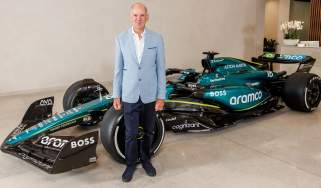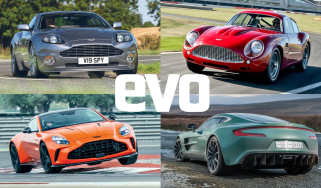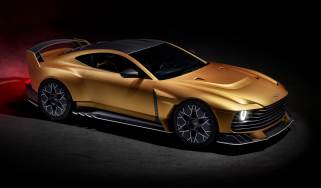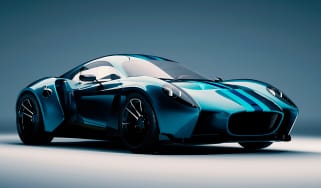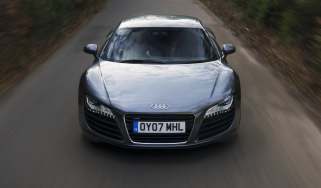Aston Martin DBR1: review, history and specs
Any DBR1 is special, but this is the actual car that won Le Mans in 1959. We tell the story of David Brown’s legendary sports racer and drive this unique piece of Aston history
It’s an oft-overlooked fact, but regulations are as much a factor for change in motorsport as new technology. Prior to 1956, World Sportscar Championship regulations insisted that competing cars had to be road-legal, so contenders like Aston Martin’s DB3S and Jaguar’s D-type were sold as road cars. It was presumably intended to stop manufacturers building thinly disguised race cars and barely civilising them for highway use, though back in the mid- ‘50s there wasn’t so much difference.
The road-legal regulation was relaxed for 1956, although that was immediately offset by a 2.5-litre limit imposed in the wake of the 1955 Le Mans tragedy. Aston Martin nevertheless embraced this new freedom to create the DBR1 from a clean sheet of paper. The 2.5-litre limit didn’t suit Jaguar or Maserati and both pulled out of the championship, leaving Aston’s bespoke baby to face a lone but formidable factory foe in Ferrari.
> Driving the one-off Aston Martin DB7 GT prototype
In 1957, the regulations changed again with a limit of 3 litres, and while that was still no good for Jaguar, Aston replaced the DBR1’s 2.5-litre all-aluminium straight six (which had been loosely based on a Lagonda engine), and installed one from the DB3S, stretched from 2.9 to 3 litres and uprated to push out about 250bhp at 6250rpm. The DB3S itself was still available and Aston made more than 30 of them, but there were just five DBR1s, all but one of which would remain as factory race cars. With this exclusive quartet, the factory embarked upon a quest to capture the World Sportscar Championship – and, of course, victory at Le Mans, which remained a stand-alone event. That would involve another contest with the Latin contingent, but also with Jaguar, Aston’s most traditional rival. Success in France against Jaguar would surely bring a showroom advantage back home.
At a glance, the D-type, the DBR1 – and the DB3S – are undeniably products of their time. The bonnet is long to cover a tall, front-mounted, in-line six-cylinder engine; there’s an oval air intake for the radiator and humps on the wings to clear skinny 16inch wheels, and the vestigial doors flex and bend as you pull them shut, then leave your shoulders feeling exposed. But look more carefully. See that the Aston has a slightly more delicate look. The curves are longer and shallower and the whole car looks smaller, wider and more ready to hug the ground. It makes for a body which has been described as ‘one of the most beautiful of all sports racing cars’, rolled and beaten from wafer-thin 20-gauge aluminium rather than the D-type’s 16-gauge in a quest for lightness. Woe betide anyone who moves to lean or sit, or the photographer who makes ready to attach a camera sucker.
Beneath this thin, swooping skin lies some individual engineering. The D-type was based on an aircraft-style monocoque tub, which was an advanced feature for the time, but the DBR1 has a spaceframe chassis made of welded steel tubes, more like a single-seater’s. The tubes saved 50lb over the DB3’s traditional ladder chassis and they criss-cross the cockpit floor, calling for a sheet of plywood to support the heels. And whereas you sit low down in the D-type, nicely trapped between transmission tunnel and sill, in the Aston you perch in a vestigial seat. This particular one was borrowed from a DBR4 Grand Prix car and is only marginally better than the yet flimsier original that still graces the passenger side. The transmission tunnel then seems impossibly slim and surely not large enough to contain something like the Jaguar’s tough four-speed gearbox, and there’s no gearlever sticking up through a hole. Instead the DB’s lever sits level with your left knee, short and stubby like a Grand Prix car’s, and when you lift the bootlid you discover it leads via a rod to a five-speed gearbox and differential, driving the rear wheels via a pair of double-jointed halfshafts. Compare that with the D’s big beam-axle tied to the tub by five links.
David Brown was an established gearbox specialist and a magnesium-cased transaxle was specially designed to sit between the rear wheels, just as it does in the tail of a Maserati 250F or Birdcage, and, in common with these, the R1 boasts five dog-engaged gears instead of the Jaguar’s synchronised four. The Aston’s transmission lies across the car rather than in line and the aim is to equalise weight distribution in a front-engined car, although the downside is that the propshaft always spins at engine speed. There’s de Dion rear suspension too – something Jaguar apparently tried but rejected in favour of the extra strength in a beam axle – with telescopic shock absorbers, a Watt’s linkage for lateral location and links to twist torsion bars in place of traditional springs. The bars run forward along the cockpit floor with the ends just visible to the sides of the seats.
The right-hand sill covers the exhausts, which jut out just below your elbow, while the left is filled with the battery and two separate oil tanks, one to feed the gearbox and another that holds no less than 20 litres for the dry-sump engine. Designer Ted Cutting clearly didn’t want oil starvation in a long race but he reduced the extra weight’s effect on the handling by putting the tanks in the middle.
The DBR1’s long bonnet is secured by rows of neat catches, which remain flush until you poke a finger at them, whereupon they obediently rotate inwards and click open. Feltham in Middlesex, where the Aston was made, was close to the centre of English aircraft production and many of the Aston workforce came from there, so that’s what they knew. The feature took more work than two bolts and a leather strap, but it creates less drag and opens quickly with no risk of losing a clip during a pit stop.
> Aston Martin Bulldog: the story of Aston's first hypercar
The 3-litre engine beneath looks compact and sits low, and it has has two plugs per cylinder, each fired by a separate distributor driven from the back end of each camshaft. You could argue that this would keep you going if you lost a plug or a rotor arm, but it probably had more to do with tardy flame travel in a hemispherical combustion chamber and the need to get the mixture burnt effectively.
There’s more individuality in the DBR’s front suspension layout; in place of the accepted geometric ideal of double wishbones (used on the D-type front end), there are large trailing links, the top ones operating a lever-arm shock absorber rather than the much better telescopic type used at the back, which was adjustable even by 1959. Then you see that each bottom link operates a transverse torsion bar running across the car. Exactly like a VW Beetle... Trailing links are an esoteric choice for front suspension, favoured mainly by pre-war German manufacturers, so possibly this was a legacy carried from former Auto Union designer Professor Eberan von Eberhorst’s original DB3 of 1951. It’s all beautifully made, cast and forged, with roller bearings everywhere and neat offset bushes and splines for all the various adjustments, but it is undeniably complicated and it involves some geometric compromises that are more significant in a race car. It’s hard to see why anyone would do it like that other than because they had and they could.
Our subject is without doubt the greatest of all DBR1s. Chassis no 2 is the car that scored the first victory for the type at Spa, in the hands of GP driver Tony Brooks, who followed that with top spot in the Nürburgring 1000km (sharing with Noel Cunningham-Reid) and another at the Spa Three Hours. Crucially, DBR1/2 is also the car that Roy Salvadori and American escapee Carroll Shelby drove to victory in the 1959 Le Mans 24Hrs. Stirling Moss was sent out in a DBR equipped with a high-compression engine as the hare to break the rest, and it worked. The icing was a second-place finish for DBR1/4 crewed by Frenchman Maurice Trintignant and Belgian Paul Frère.
Equally importantly, No2 is the hero that sealed the 1959 world championship for Aston Martin at a dramatic Goodwood Tourist Trophy. A fire in the pits put the leading DBR1/3 of Stirling Moss and Roy Salvadori out of the race, but Moss joined Jack Fairman and Carroll Shelby in DBR1/2 and drove to victory. In its illustrious career, this car scored a total of eight wins from 18 races and its place in Aston history is beyond compare.
The Aston’s engine may be smaller than a Jaguar’s, both physically and in displacement, but it spins considerably faster. In the day the drivers used 7000rpm, which is close to Ferrari V12 territory and about 1500 more than allowed in Coventry, and when you consider that the Aston weighs about 860kg against the Jaguar’s 1090kg, the R1’s oft-quoted power disadvantage against the D-type doesn’t sound so much. Ferrari may still have been a different matter however… Perversely then, the item that caused the greatest number of problems in period was the specially designed gearbox, which, although ideal in theory, was not considered very pleasant to handle. Aston apparently knew that and even experimented with one borrowed from a Maserati. The Italian transaxle is a fast-shifting delight, but rather than dismantling it to find out what made it better, Aston reverted to the DB ’box.
Behind the wheel of an Aston Martin DBR1
By the time I got to drive DBR1/2, almost 50 years on, the gearbox had been equipped with a set of different dog rings courtesy of R1 expert Tim Samways, and he had also stiffened the torsion bars and revised the internals of the dampers to prop up the car for modern historic racing and the modern era’s smoother tracks. The engine, too, had benefited from some logical fettling, and apparently now pushed out about 280bhp, or about the same as modern tuners have managed to extract from the 3.4-litre Jaguar engine. Now as then… Time to see whether the car’s advantages were still apparent and where they might lie…
The replacement seat still has a back that is too vertical for me to be properly comfortable, but it does boast another improvement in the shape of extra brackets to stop it flexing about. I have discovered so many times that a flexible seat means I end up hanging on to the wheel just when the arms need to be relaxed and mobile. I’ve never understood how the fast men managed at the time, especially as they wouldn’t have had the full harness belts which are also a retro-fit. Flick the switches salvaged from an aviation parts-bin and press the starter. Hear the electrical whirr then the musical bark followed by a searing crackle as you back off that only six cylinders arranged in-line can make. Wait an age for temperature in the vast quantity of oil to lift the needle on the gauge, then reach down for the stumpy lever, which falls straight into the palm, lift the spring-loaded catch that guards the slot for first gear slot (the gate is modern-conventional with first to the left and forward but the catch is another Samways improvement that stops an enthusiastic shifter finding first instead of third) and off you go.
So far so good. The clutch (which is on the back of the engine) is smooth, and the gears – once the oil circulating from the tank has also warmed a little – are also easy. Like the seat, a set of better dog rings is a simple improvement that was available at the time, so it’s hard to know why they didn’t fit them. The gear gate is maybe still not quite so well defined as the contemporary Maserati’s, but the lever’s movement is shorter, maybe six inches in total, and the faster you throw it, the less effort it takes and the smoother the shift. It is definitely a fingertip rather than a clenched fist activity and so much faster than the Jaguar’s change which makes you wait for the synchros to catch up. The engine is smooth and sweet but needs to be kept between five and six-eight for it to work best. Kept there, it brays and wails, sounding as revvy as it is. Let it drop too low and it stumbles, so it’s just as well there are five gears.
If the drivers of the day weren’t so keen on the DBR1’s gearshift, they were united in approval of its handling. As I ease out of the pits area, the creaking and groaning from the torsion bars and links is a curiously nautical touch, audible even above the rasp of the engine and the whistling whine of the transaxle that wells from behind, but the car now feels very stiff indeed, following each ridge and rut with faithful accuracy. And yet as I up the speed it does begin to flow. You can tell a lot about cars – particularly historic ones – from the first response to the wheel: does it roll as a whole or does it sit or sag at one end or the other? Is there lost motion when you straighten up, the kind that will add a useful (or unwelcome) extra to any input you make? Send you flopping back the other way if you don’t straighten up neatly. And the brakes, the essential that compromised so many cars of the period? The DBR1 has Girling discs all round with dual circuits which, perhaps surprisingly, was standard at the time. With the added benefit of modern fluids and friction materials, the brakes feel firm and powerful, just like a modern GT’s.
DBR1/2 turns out to be an unusual mixture of ancient and modern and not just because of the brakes and more modern spring rates but because the response to the wheel is instant. The vintage touch is a body that rolls as a whole – more like a C-type Jaguar made three or four years earlier – but the Aston does it more quickly, which makes the car feel sharper and more up to date. You still feel the roll, but then almost immediately the Aston will take a set without my asking, yawing its tail about five or ten degrees to the side. It’s a familiar characteristic of cars of the period – and the Dunlop tyres, which are made in period moulds – but once again, the DBR1 seems to do it more quickly and there’s no wait for the inertia to build. Hold that yaw with a dose of power, tickling it more and more through the corner until you’re flat by the exit. Too little and the car will lose its yaw and start to push at the front. Too much and it suddenly begins to slither wide. It’s familiar, but with added zest, and there’s a distinctly thoroughbred feel about everything.
When it does finally protest and sling its tail, you hear the inside rear tyre give up the struggle and start to spin. The revs rise in an instant and you need a big dose of opposite lock – and for that you need a well-braced torso and strong arms. The steering has also been speeded up a touch, which makes it heavier, and I’d be interested to know what Shelby, Moss and the rest had to cope with. Maybe when the car was softer, it arrived a bit more gently; as it is, when you need to summon that effort, the momentum is gone. It’s a fine line you have to tread.
The difference between this and, say, the D-type is the speed of response. The D makes you wait, slides further but makes it easy to sort out. Lets you play like the feline it is, but doesn’t have the claws if you overstep the mark. And the difference between either and a heavier GT – like a GTO, which has to be drifted to keep the momentum – is the balance. You have to lift the GTO and put it where you want it, manage the mass to get it going. The Aston does that for you and it does seem that the lower overall weight, the 50:50 weight distribution from a light engine and the gearbox in the back, are major factors. More like an Italian Grand Prix car of the period, which shared a similar layout.
It’s fascinating how hindsight allows us to focus on the engineering culture of each manufacturer, but the Aston DBR1 did what it was built to do, capturing the World Championship and Le Mans and doing it in the manufacturer’s own style. Jaguar went for size and stamina; Aston went smaller and lighter and spun everything faster. It was all to be short-lived though. Buoyed by the success, David Brown decided to tackle Grand Prix racing and pulled out of sports cars and the DBR1s were sold to private customers who campaigned them for another couple of years. DBR1/2 was once again the most successful, winning the 1960 Rouen Grand Prix with regular driver Jack Fairman and long-time privateer Graham Whitehead, the man who had handed over his pit to help seal the 1959 World Championship. Following the 1962 season, all DBR1s had found their way into museums or private collections, reappearing many years later in the burgeoning historic race car world, which could afford to keep them in the style to which they had been born.
This story first appeared in issue 002 of 'Vantage', our quarterly sister magazine based on all things Aston Martin. Subscribe to Vantage magazine here.
